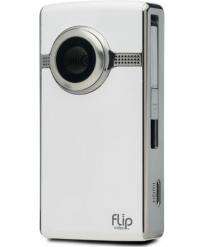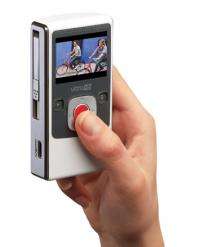Latest Flip is bigger, but better

Since its debut in 2007, the Flip video camera has turned millions of people into filmmakers by providing a foolproof way to shoot videos and upload them to the Web.
Last week, Flip maker Pure Digital Technologies released two new versions -- the Flip Ultra ($150) and the Flip UltraHD ($200).
With these new additions, there are now four Flip cameras to choose from -- standard and high-definition versions of the Flip Ultra and the Flip Mino, which are sleeker, more expensive models.
I'm going to focus on the Flip UltraHD and how it compares to the Flip MinoHD ($230), because I suspect many consumers (myself included) will be choosing between these two.
The Ultra weighs almost twice as much as the Mino and is a lot bulkier. It still fits in your pocket, but it's not nearly as sleek or stylish as the Mino, which takes up so little space you may not even realize it's in your bag. Unlike the Mino, which you can buy in a variety of colors and even create your own custom design, the Ultra is available only in black and white.
But if you can get past the size and aesthetic differences, there's a lot to like about the Ultra. It can hold two hours of HD video -- twice as much as the Mino. It has a vibrant, 2-inch screen with a higher resolution, which makes it easy to see what you are shooting outside. The Mino HD has a 1.5-inch screen, which sometimes makes it hard to frame your shots.

Another improvement is the Ultra's power source, a sort of hybrid solution. The Mino has a sealed internal battery that you charge on a computer, meaning you never have to buy batteries. But if you run out of juice and aren't near a computer or USB power source, you're out of luck. The Ultra comes with a AA battery pack, which you can charge with the USB port on your computer and can also replace with regular AA batteries in a pinch.
The Ultra has a port that lets you connect it directly to your TV with an HDMI cable so you can watch your videos in stunning HD quality. Unfortunately, the cable isn't included, but you can buy one from Pure Digital for $25. The Mino comes with cables to connect it to your TV, but they are not HD cables, so your video will play in standard definition.
The Mino features buttons that you tap on lightly to operate while the Ultra has more traditional buttons that require a hard push. Although the Mino's buttons look much cooler, they can be frustrating. The quality of the video was comparable, although the Ultra's video and audio seemed a little crisper. However, the Mino did a slightly better job stabilizing shaky images.
Both cameras come with the Flip's signature built-in software that runs on both PCs and Macs and automatically installs when you pop out the USB arm on the camera and connect it to the computer.
Yet another option for a compact, HD camera is the Kodak Zx1 ($150), which is about the same size as the Mino and also comes in lots of colors. The key difference is that unlike the Flip cameras, the ZX1 has an SD card slot, so you can potentially record up to 10 hours of HD video, depending on the card's size.
The Kodak model has a rugged design and rubberized ports, so it's resistant to rain, snow, sand and dirt. But in order to make it so tough, Kodak was not able to include a built-in USB arm to connect it to a computer, so you have to use the included USB cable. The software it comes with has a lot of features, including the ability to upload to both YouTube and Vimeo, but it's nowhere near as easy to use as the on-board Flip software. It also works only on PCs (though you can transfer files from the camera to a Mac).
Like the Flip Ultra, it has an HDMI port to connect the camera to your TV and it actually comes with the cable. It also has a rechargeable AA battery pack, but since there's no built-in USB arm, you have to charge it with the supplied adapter. It can also record in both standard and high definition.
The Zx1 has a lot more features than the Flip, but part of what makes the Flip cameras so popular are how simple and fun to use they are. With the Zx1, you'll be checking the manual pretty often. But, if you don't mind a learning curve and want more features and functions, it's a good option.
Choosing between the Flip MinoHD and the Flip UltraHD comes down to what's important to you. If it's all about looks and size, then go for the Mino. But if you can stand the extra bulk, and for $30 less getting twice the storage space and a bigger, more vibrant screen, the Ultra is a better choice.
___
(c) 2009, The Orlando Sentinel (Fla.).
Visit the Sentinel on the World Wide Web at www.orlandosentinel.com/
Distributed by McClatchy-Tribune Information Services.



















